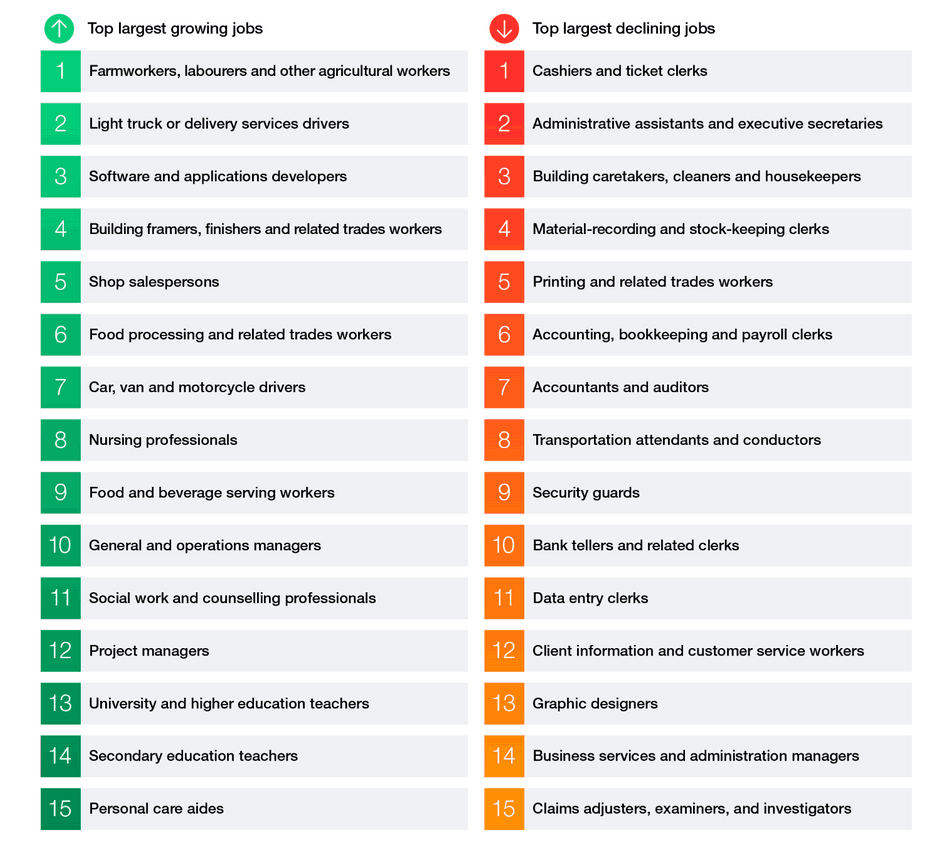Naturally, there is much, much, much talk of Donald Trump at the World Economic Forum in Davos, which opened on Monday 20 January. It makes up a lot of the discussion... but not all of it. The future of employment and the transformation of the labour market by 2030 are also amongst the hot topics on the table.
Ahead of the discussions, the forum produced a (generous) report of almost 300 pages. The document states that “technological change, geo-economic fragmentation, economic uncertainty, demographic shifts and ecological transition are among the main factors expected to shape and transform the global labour market.”
To reach these conclusions, a thousand “leading” employers were surveyed, representing “more than 14m workers in 55 economies around the world.”
All this comes at a time when almost 22% of current jobs will change by 2030, according to the International Labour Organisation (ILO). This figure includes the creation of new jobs (14%) and the disappearance of certain occupations (8%). In total, 78m jobs will be created, an increase of 7% on the current number of jobs.
The impact of technology
Job growth will be particularly fuelled by technology. 60% of employers surveyed expect technology to transform their business by 2030. Jobs in the artificial intelligence, robotics, big data and software sectors (fintech engineer, AI specialist, software developer, etc.) will rise sharply.
By 2030, the proportion of tasks carried out exclusively by humans will be reduced, largely replaced by the machine-algorithm pair. Almost 82% of the reduction in human tasks will be due to automation, with the remainder attributed to human-machine collaboration.
This development does not imply a complete disappearance of human tasks, insists the forum’s report. Interaction between humans and machines will be essential. And the future of work will be based on an increase in human capacities thanks to technology.
Changes brought about by the green transition
Similarly, the energy transition and the fight against climate change (with or without Donald Trump) will play a decisive role in shaping the global labour market: 41% of employers expect the “green wave” to have an impact on their business over the next five years.
As a result, jobs associated with the environment (engineer, electric and autonomous vehicle technician, sustainable development expert, etc.) will be in high demand. “The growing adoption of energy production, storage and distribution technologies, as well as other technological trends, are additional contributing factors,” adds the report.
The agricultural sector will also be affected by these changes. It is estimated that 35m new jobs will be created by 2030, boosted by investment in the ecological transition.
The weight of tensions
Marked by a profusion of geopolitical tensions, industrial policies and other restrictions on world trade, geo-economic “fragmentation,” as the authors of the report describe it, will also influence the labour market. Companies will be faced with new dynamics, which could generate up to 5m additional jobs. Jobs in logistics, security (particularly cybersecurity) and strategy will be the most affected.
Another consequence of this “fragmentation” could be the use of relocation practices. For example, companies under pressure from trade restrictions could choose to repatriate some of their production. This could create jobs in sectors such as economic analysis and supply chain management.
Demographic changes
Demographic trends (an ageing population, slower population growth) are not without their effects. The care sector, in particular, is set to experience strong demand. This means a growing need for health and social care professionals, such as nurses, care assistants and social workers. These professions will be among the biggest job creators between now and 2030.
At the same time (and quite logically), the ageing of the population will contribute to the demand for services for the elderly.
Several speeds
Some industries will experience rapid acceleration. But others--farm labourers, delivery drivers, construction workers, as well as care and education workers, for instance--will see their jobs multiply.
At the same time, jobs such as cashier or counter clerk, but also administrative assistant, executive secretary, printing worker, accountant or auditor will become increasingly rare due to automation and AI.

The fifteen jobs for which figures are expected to increase or decrease the most between now and 2030. Image: World Economic Forum, “Future of jobs Report 2025”
Economic uncertainty
Economic uncertainty is one of the main concerns hanging over the future of employment.
One in two employers say that the rising cost of living will directly affect their organisation between now and 2030. However, the impact of this uncertainty could be mitigated by sustained growth in other sectors, fuelled by technological trends and efforts to reduce carbon emissions.
The takeaway...
The differences in skills between jobs that are growing and those that are declining are likely to increase the skills gap between the two. The report projects that by 2030, if the global workforce consisted of 100 people, 59 of them would need training. And of these, if we go further, 29 could be trained in their current position, 19 redeployed elsewhere in their company, while 11 would (probably) receive no training at all.
As a result, skills shortages are seen as the main obstacle to business transformation. 63% of employers identify this as a “major” problem between 2025 and 2030.
To address this issue, 85% of employers plan to put upgrading the workforce at the top of their priority list. 70% of employers plan to hire new talent with in-demand skills, 40% to reduce headcount, and 50% to redirect their employees towards growth positions. A huge undertaking.
This article was originally published in .
